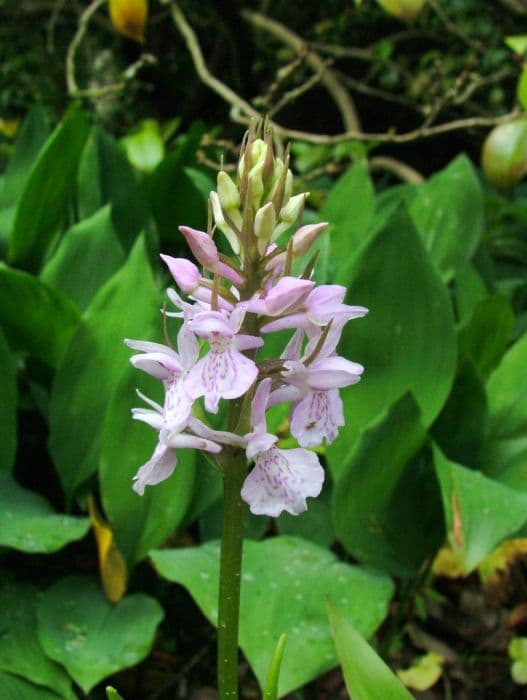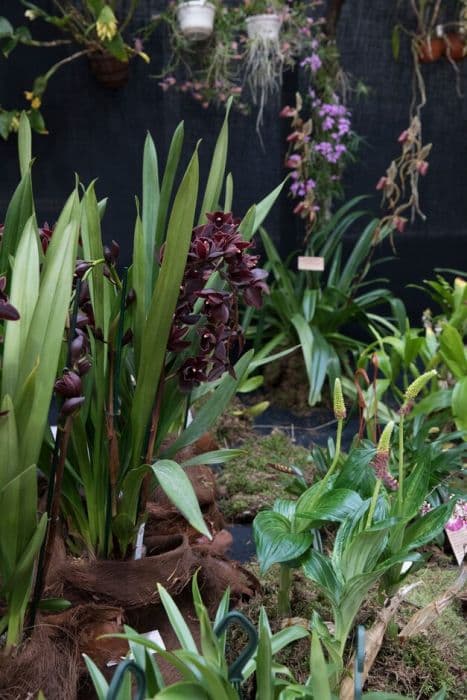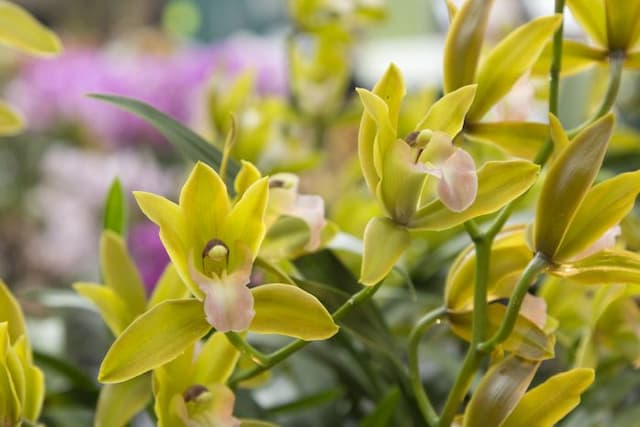Spotted orchid Dactylorhiza maculata

ABOUT
Dactylorhiza maculata, commonly known as the spotted orchid, is a perennial plant known for its distinctive and attractive appearance. The foliage of the spotted orchid is characterized by a rosette of lance-shaped leaves at the base, which typically feature dark, somewhat random spots or blotches. These leaves give the plant its common name and add to its ornamental value. The flowers are the most striking feature of the spotted orchid. They are small and intricate, arranged on a spike that rises above the leaves. Each individual flower is typically shaped like a small helmet or hood, with a prominent lip that is three-lobed and often marked with distinctive patterns or spots that can range in color from light to dark. The overall color of the flowers varies, including various shades of pink, purple, and sometimes white, blending beautifully in natural settings. The spotted orchid's flowers contain both male and female reproductive parts, which are fused into a column in the center of the flower, a common characteristic in orchids. This arrangement facilitates cross-pollination by insects, which is vital for the reproduction of the plant. The spotted orchid can be found growing naturally in a variety of habitats, including meadows, grasslands, and woodlands, where it blends with the greenery of the landscape until its flowering period. Once in bloom, it becomes easier to spot due to the showy spikes of the colorful flowers that provide a visual contrast to its surroundings. Root-wise, the plant has a tuberous structure that allows it to store nutrients to survive the winter and regenerate in the spring. This contributes to the plant's resilience and ability to come back year after year. In summary, the spotted orchid is a charming and elegant plant with a patterned foliage base and a striking spike of beautiful pink to purple flowers that stands out in its natural habitat. Its decorative appearance has made it a favorite among enthusiasts and naturalists alike.
About this plant
 Names
NamesFamily
Orchidaceae.
Synonyms
Heath Spotted Orchid, Moorland Spotted Orchid, Spotted Orchid, Flecked Orchid.
Common names
Orchis maculata, Dactylorchis maculata, Orchis fuchsii, Dactylorhiza fuchsii, Dactylorhiza elodes, Orchis elodes, Orchis maculata var. elodes, Orchis maculata var. fuchsii, Dactylorhiza sudetica, Orchis sudetica, Dactylorhiza fuchsii var. okellyi, Orchis latifolia, Orchis latifolia var. brachycera, Dactylorhiza fuchsii var. psychrophila.
 Toxicity
ToxicityTo humans
The common name for Dactylorhiza maculata is the heath spotted-orchid. This plant is not commonly known to be toxic to humans. There is scant information regarding its edibility or potential toxicity, but it is not generally regarded as a plant that poses a risk when touched or ingested. As with many plants, individual sensitivities or allergic reactions are possible, but there are no well-documented cases of poisoning from the heath spotted-orchid in humans.
To pets
The heath spotted-orchid, Dactylorhiza maculata, is not typically listed as a toxic plant to pets. There is limited information on its effects if ingested by animals; however, it is not commonly associated with poisoning in pets. As always, it is advisable to prevent pets from ingesting plants that are not confirmed to be safe, as individual animals might have different sensitivities or reactions. If a pet ingests this plant and shows any signs of distress, it is best to contact a veterinarian.
 Characteristics
CharacteristicsLife cycle
Perennials
Foliage type
Deciduous
Color of leaves
Green
Flower color
Varies
Height
1-2 feet (30-60 cm)
Spread
1 foot (30 cm)
Plant type
Herb
Hardiness zones
4
Native area
Europe
Benefits
 General Benefits
General Benefits- Ecosystem Support: Dactylorhiza maculata provides nectar for various pollinators, supporting local ecosystems.
- Biodiversity Promotion: This orchid contributes to the floral diversity of an area, fostering a healthy environment for all species.
- Aesthetic Value: The spotted orchid, with its distinctive spotted leaves and spikes of flowers, adds visual interest to gardens and natural spaces.
- Educational Interest: It is a subject of interest for botanists and nature enthusiasts, ideal for educational purposes on plant identification and biodiversity.
- Habitat Creation: Dactylorhiza maculata can create microhabitats within their structure for smaller organisms like insects.
- Soil Erosion Control: The root systems of the spotted orchid can help stabilize soil, preventing erosion in their native environments.
 Medical Properties
Medical Properties- Antidiarrheal: Traditionally used to treat diarrhea.
- Antiseptic: Applied topically for its alleged antiseptic properties.
- Astringent: Has been used to tighten tissues and reduce secretions.
- Demulcent: Thought to soothe irritated mucous membranes.
- Homeopathic remedies: Dactylorhiza maculata is used in homeopathy for various conditions, although these uses are not supported by scientific evidence.
 Air-purifying Qualities
Air-purifying QualitiesThis plant is not specifically known for air purifying qualities.
 Other Uses
Other Uses- Ecological indicator: Spotted orchid (Dactylorhiza maculata) presence can indicate the quality of the habitat, especially in meadows and grasslands, as it requires specific conditions to thrive.
- Photography and art: The unique spotted patterns of the leaves and the striking flowers make it a popular subject for photographers and artists who specialize in botanical subjects.
- Education and research: Spotted orchid is used in educational settings as a prime example of plant evolution and pollination ecology.
- Biomimicry inspiration: The structure and surface of the Spotted orchid's flowers have inspired designs in materials engineering and nanotechnology for its water-repellent properties.
- Garden and landscape design: Due to its aesthetic appeal, Spotted orchid is cultivated and used in garden and landscape design to add color and variation.
- Cultural symbol: In some cultures, the Spotted orchid is a symbol of nature's delicate beauty and is used in festivities and cultural ceremonies.
- Culinary decoration: Although not edible, the flowers can be used as decorative elements for plating in high-end culinary presentations.
- Floristry: The Spotted orchid's blooms are used in floral arrangements and as part of bridal bouquets for special occasions.
- Fragrance extraction: The scent of Spotted orchids, although not commonly used, can be extracted and studied for potential use in perfumery.
- Conservation efforts: Spotted orchid serves as a flagship species for conservation campaigns aimed at protecting wetland habitats and biodiversity.
Interesting Facts
 Feng Shui
Feng ShuiThe Spotted Orchid is not used in Feng Shui practice.
 Zodiac Sign Compitability
Zodiac Sign CompitabilityThe Spotted Orchid is not used in astrology practice.
 Plant Symbolism
Plant Symbolism- Fertility: Dactylorhiza maculata, commonly known as the Spotted Orchid, often symbolizes fertility due to its tuberous roots that somewhat resemble testicles, from which the family name Orchidaceae is derived.
- Beauty: As a member of the orchid family, the Spotted Orchid is often associated with beauty and elegance, representing refined and delicate attractiveness.
- Opulence: Orchids, in general, have a connotation of luxury and opulence due to their exotic appearance and the historical rarity in distant lands, yet the Spotted Orchid can also carry this symbolism, being a part of the prestigious family.
- Love and Desire: Many orchids have long been symbols of love and desire, owing to their sensual shapes and the rich variety of colors, so the Spotted Orchid would also be a part of this tradition.
- Charm and Grace: The Spotted Orchid can also symbolize charm and gracefulness, given its poised and delicate stance in its natural habitat.
- Virility: Due to its reproductive strategy and root shape, Spotted Orchid may also be a symbol of male virility, mirroring ancient Greek and Roman associations of orchids with male sexuality.
 Water
WaterSpotted orchid watering should mimic their natural boggy habitat, so keep the soil consistently moist but not waterlogged. During the growing season, spring through fall, water the plant with about 1/4 to 1/2 gallon of water once a week. Ensure proper drainage to avoid standing water, which can lead to root rot. In winter, reduce watering to every other week as the plant enters a period of dormancy. Always use room temperature water to avoid shocking the plant's roots.
 Light
LightSpotted orchids thrive in light conditions that are bright but indirect. The ideal spot for a spotted orchid would be a location where it's shielded from the harsh midday sun, such as behind a sheer curtain or in a room with east-facing or north-facing windows. Direct sunlight can cause leaf scorch, while too little light can inhibit flowering.
 Temperature
TemperatureSpotted orchids prefer temperate conditions and will flourish in an environment where temperatures range between 50°F and 70°F. They can tolerate a minimum temperature of around 40°F but should not be exposed to temperatures below this as it can cause damage to the plant. The ideal temperature range to maintain for these orchids is from 50°F to 65°F to mimic their natural cool habitat.
 Pruning
PruningPruning spotted orchids is not typically necessary, but you can remove any dead or damaged leaves and faded flower spikes to maintain a tidy appearance and promote healthy growth. The best time to prune is after flowering, usually in late summer or fall. This light pruning helps the plant conserve energy for the next growth cycle and can potentially encourage new growth.
 Cleaning
CleaningAs needed
 Soil
SoilSpotted orchid prefers a soil mix that is rich in organic matter with good drainage. A mix of loam, leaf mold, and sand is ideal, providing an acidic to neutral pH between 5.5 and 7.0.
 Repotting
RepottingSpotted orchids should generally be repotted every two to three years or when the potting mix starts to degrade.
 Humidity & Misting
Humidity & MistingSpotted orchids thrive best at high humidity levels, ideally around 70-80%.
 Suitable locations
Suitable locationsIndoor
Place in bright, indirect light with high humidity.
Outdoor
Partial shade, moist soil, shelter from strong winds.
Hardiness zone
4-9 USDA
 Life cycle
Life cycleThe Spotted Orchid (Dactylorhiza maculata) begins its life cycle as a seed, which upon encountering the right mycorrhizal fungi, germinates to form a protocorm, a small plantlet that obtains nutrients symbiotically from the fungus. As it matures, it develops a tuberous root system and a rosette of leaves. Following vegetative growth, it enters a period of dormancy, where it remains underground through winter. In spring, it emerges and produces flower spikes with a pattern of distinct spots, leading to pollination predominantly by insects. After successful pollination, the flowers develop into seed capsules that release numerous tiny seeds, completing the reproductive cycle. The plant often remains dormant for one or more seasons before resuming growth, and can live for several years, repeating the flowering and seeding cycle annually.
 Propogation
PropogationPropogation time
Spring to Summer
Dactylorhiza maculata, commonly known as the spotted orchid, is primarily propagated through division, which is best done when the plant is dormant, usually in late summer to early autumn. This involves carefully digging up the orchid's tuberous roots and gently separating them, ensuring that each division has at least one growth point or eye. After division, the sections can be replanted at a depth that allows the top of the root to be just below the soil surface. These divisions should be spaced around 12 inches (30 centimeters) apart to allow for adequate growth. Water the newly planted divisions thoroughly to help establish them.









